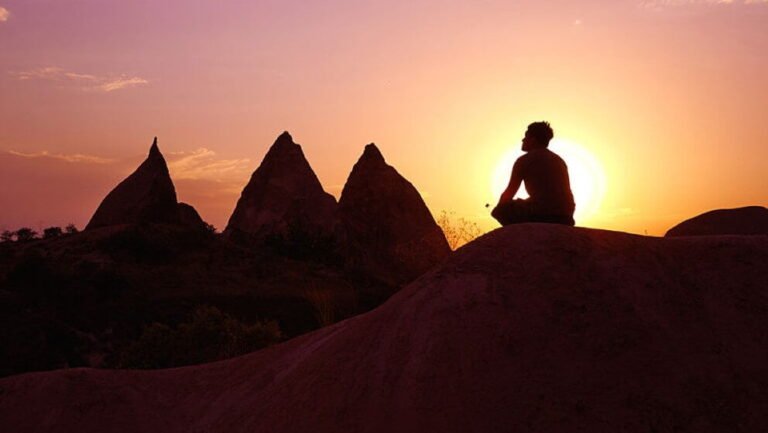The actual practice of meditation is definitely not something we can actively ‘do’, rather it describes the spontaneous action of something that happens as a result of everything else
https://www.doyou.com/dhyana-the-7th-limb-of-yoga-explained-66579/
https://www.ekhartyoga.com/articles/the-8-limbs-of-yoga-explained
(Read our introduction to the 8 limbs of yoga here…)
Dhyana (Meditative Absorption): The Seventh Limb of Patanjali’s Eight Limbs of Yoga
When you lie in Savasana after a good yoga class, you tend to feel relaxed, carefree, and almost weightless. The body is free from tension, the mind is calm, and all of a sudden, there is just more space within you.
This is the perfect place to continue into meditation, or dhyana.
What is Dhyana?
Dhyana is the 7th limb of yoga, building upon asana (physical posture), pranayama (breath control), pratyahara (control of the senses, moving the focus to the inside), and dharana (concentration). The word dhyana comes from the Sanskrit word dhyai, which means “to think of.”
Dhyana involves concentration and meditation on a point of focus with the intention of knowing the truth about it. This deeper concentration of the mind is the instrument of self-knowledge where one can separate illusion from reality, and eventually, reach the ultimate goal of yoga: samadhi (bliss, or union with the source).
Dhyana in Practice
For the regular yoga practitioner like you and me, this may sound very high and mighty. We are practicing yoga to feel good, to learn more about ourselves, and to find moments of peace during otherwise hectic days. Finding a permanent state of bliss sounds, perhaps, a bit out of our league.
But let’s not get discouraged; Yoga is here to show us the way and to give clues and guidelines. We can each take from it what is relevant for us today.
According to the Yoga Sutra, the purpose of meditation is to interrupt the fluctuations of the normal mental activity such as sensory knowledge, memory, and imagination. Out of these, memory is the hardest one to quiet, as it incessantly feeds us glimpses from the past along with an endless stream of thoughts and feelings.
Like any other limb in yoga, meditation is a systematic process in itself, which takes practice (and patience!) to learn. It’s like taming a puppy that would much rather run around than sit still. You will need to train your mind to come back to you when you tell it to and to sit still, even if for just a few seconds at a time.
When we become completely absorbed in the focus of Meditationour meditation, this is when we’re really meditating. All the things we may learn in a class, online or from a teacher are merely techniques offered to each person in order to help them settle, focus and concentrate, the actual practice of meditation is definitely not something we can actively ‘do’, rather it describes the spontaneous action of something that happens as a result of everything else. Essentially; if you are really meditating, you won’t have the thought ‘oh, I’m meditating!’…. (sound familiar?)
How to Start with Meditation
In dhyana, we focus the mind on a particular object and practice becoming absorbed in it. You can pick any object that feels relevant for you today. It could be a body part, a chakra, a person, or a beautiful flower you can focus on.
Then, prepare for the physical part of meditation, which is the solid foundation. When you start, ideally you have just done some asana practice so that your body feels comfortable to be completely still for a while.
Find yourself a comfortable position, whether sitting up or supported by a wall. Don’t get caught up in the physical posture–anything that you can hold comfortably for a long time will do. Make sure you have some quiet and that there will be no interruptions. Start with just 5 to 10 minutes at a time, until you become more used to it.
The Benefits of Dhyana
Meditation has benefits for both the body and the mind. It will release stress from the body, your mind will feel calmer, and you will feel more at ease in your life. We can find more peace of mind in our daily business by acknowledging the space between external events and our reaction to them.
As we listen to ourselves more and sit in silence, we become more aware of who we actually are. And this, of course, is a wonderful and beautiful goal.

